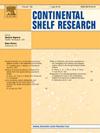Multiscale sea level variability on the western Bay of Bengal: A study using tide gauge and satellite observations
IF 2.2
3区 地球科学
Q2 OCEANOGRAPHY
引用次数: 0
Abstract
The study examines the tidal variability and intraseasonal oscillations (ISOs) of sea level using tide gauge observations collected during the year 2014 at four stations: Gardenreach, Paradeep, Kakinada, and Ennore along the western Bay of Bengal (BoB). In the first part, the tidal analysis of sea level data shows the dominance of M2 tides followed by S2, N2, K1, and O1 at all the stations. The tides are usually semidiurnal in nature over BoB, represented through the form factor, which is maximum over Ennore (0.21) and minimum over Gardenreach (0.10). The tidal amplitudes increase gradually northward along the western BoB due to interaction with the shallow continental shelf. The topography and coastal geometry also impact the shallow-water constituents (M4 and MS4) significantly at all the locations. Another noteworthy finding is the higher amplitude of M2 tide during the post-monsoon seasons because of the higher stratification of the water column. In the second part, the presence of different non-tidal signals from the residual sea level and altimetry gridded data are studied as well. The correlation coefficient between Sea Level Anomaly (SLA) data from altimetry and the Tide Gauge data are as high as 0.94, 0.91, and 0.90 at Paradeep, Kakinada and Ennore, respectively. The spectral analysis ensures the dominance of the signals with periodicity of 20–60 days in the BoB, which is probably caused due to the monsoon ISOs and Madden Julian Oscillations. The 10–20 days oscillations are also observed with significant amplitudes primarily at Gardenreach which attributes to the Quasi-Biweekly Oscillations. The signature of seasonally varying coastally trapped Kelvin Waves is also identified on the western BoB from both the satellite and Tide Gauge data. The strength of the intraseasonal variability significantly increases during negative Indian Ocean Dipole years with respect to the positive years. The study identified the usefulness of the sea level observation to monitor the multiscale variation within the tides to the interannual scales along the Indian coast.
孟加拉湾西部的多尺度海平面变化:利用验潮仪和卫星观测数据进行的研究
本研究利用 2014 年在四个站点收集的验潮仪观测数据,研究了海平面的潮汐变化和季内振荡 (ISOs):Gardenreach、Paradeep、Kakinada 和 Ennore 四个站点。在第一部分,海平面数据的潮汐分析表明,所有站点的潮汐都以 M2 潮汐为主,其次是 S2、N2、K1 和 O1。波罗的海潮汐通常是半周期性的,通过形式因子可以看出,恩诺尔潮汐最大(0.21),加登里奇潮汐最小(0.10)。由于与浅大陆架的相互作用,潮汐振幅沿 BoB 西部向北逐渐增大。地形和沿岸几何形状对所有地点的浅水成分(M4 和 MS4)也有很大影响。另一个值得注意的发现是,在季风后季节,由于水体分层程度较高,M2 潮汐的振幅较大。第二部分还研究了残余海平面和测高网格数据中存在的不同非潮汐信号。在 Paradeep、Kakinada 和 Ennore,测高法海平面异常(SLA)数据与验潮仪数据的相关系数分别高达 0.94、0.91 和 0.90。频谱分析表明,在 BoB 中,周期为 20-60 天的信号占主导地位,这可能是季风 ISO 和马登-朱利安振荡造成的。此外,还观测到 10-20 天的振荡,振幅很大,主要发生在加登里奇,这是准双周振荡造成的。从卫星和验潮仪数据中,还可以发现博白西部存在季节性变化的海岸滞留开尔文波。在印度洋偶极子负年与正年相比,季节内变化的强度明显增加。研究表明,海平面观测有助于监测印度沿岸潮汐的多尺度变化和年际尺度变化。
本文章由计算机程序翻译,如有差异,请以英文原文为准。
求助全文
约1分钟内获得全文
求助全文
来源期刊

Continental Shelf Research
地学-海洋学
CiteScore
4.30
自引率
4.30%
发文量
136
审稿时长
6.1 months
期刊介绍:
Continental Shelf Research publishes articles dealing with the biological, chemical, geological and physical oceanography of the shallow marine environment, from coastal and estuarine waters out to the shelf break. The continental shelf is a critical environment within the land-ocean continuum, and many processes, functions and problems in the continental shelf are driven by terrestrial inputs transported through the rivers and estuaries to the coastal and continental shelf areas. Manuscripts that deal with these topics must make a clear link to the continental shelf. Examples of research areas include:
Physical sedimentology and geomorphology
Geochemistry of the coastal ocean (inorganic and organic)
Marine environment and anthropogenic effects
Interaction of physical dynamics with natural and manmade shoreline features
Benthic, phytoplankton and zooplankton ecology
Coastal water and sediment quality, and ecosystem health
Benthic-pelagic coupling (physical and biogeochemical)
Interactions between physical dynamics (waves, currents, mixing, etc.) and biogeochemical cycles
Estuarine, coastal and shelf sea modelling and process studies.
 求助内容:
求助内容: 应助结果提醒方式:
应助结果提醒方式:


